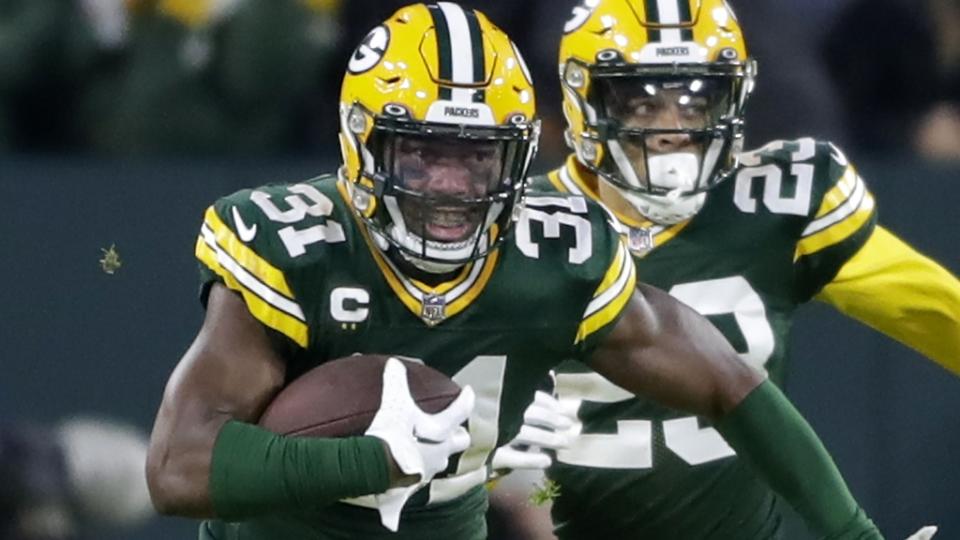How does Adrian Amos fit into the Jets' defensive scheme?

The Jets had a good plan for the safety position this offseason, moving swiftly to negotiate a trade with the Baltimore Ravens that would bring in a viable starter in Chuck Clark for the bargain price of one late-round pick. Clark could be paired with the incumbent Jordan Whitehead to give the Jets a safety tandem with youth, experience, athleticism and versatility.
Unfortunately for the Jets, Clark suffered a knee injury during organized team activities earlier this month and the Jets’ worst fears were confirmed as Clark was diagnosed with a season-ending ACL tear. It was disappointing news for the Jets and Clark, who had been durable with the Ravens and looked like he might be a solid replacement for the outgoing veteran Lamarcus Joyner.
As soon as the Clark injury happened, the Jets moved quickly to find his replacement, as they signed Adrian Amos. The 30-year-old was one of the top unsigned free agents on the market and it’s probably more than a coincidence that he spent the last four years as Aaron Rodgers’ teammate in Green Bay, where he was a captain in 2022.
Whitehead and Joyner did pretty well together last season as they combined for 146 tackles and five of the team’s 12 interceptions. However, Joyner and Clark’s skill sets are not identical so they may have been planning to tweak the defensive system in 2023. Now that Amos is on board will the Jets revert to something more similar to what they did last season, or persevere with the new plan?
Head coach Robert Saleh has shown in the past that he’s willing to adapt his scheme to suit the personnel on his roster. In San Francisco, he initially wanted to run a Cover 3 zone similar to the one Pete Carroll would have been running while Saleh was in Seattle. However, after a few years, Saleh saw more success with Cover 2 defenses and helped develop the 49ers’ defense into one of the league’s best and a unit capable of carrying them to a deep postseason run. This is ultimately what led to Saleh establishing himself as a viable head coaching candidate and ending up with the Jets.
Saleh’s Jets roster already looks very different than it did when he started. One of the main differences is that he now has a pair of stud corners on the outside, freeing up the safeties to be used in other ways than just providing downfield support. That may have informed their approach this offseason.
Critics of the Clark move noted that both he and Whitehead were better in the box than in downfield coverage and expressed concern that this would leave the team without a deep centerfield option. It’s important that the Jets have safeties that can come up into the box and fill gaps, though, because they operate with wide-nine fronts that can create big gaps at the line of scrimmage.
The good news is that Amos, who began his career as a free safety, has been increasingly playing more in the box and has developed into an excellent run defender in his own right. However, he has still lined up as a deep safety rather than in the box most of the time, so he’s more than comfortable dropping into a deep-safety role when Whitehead creeps up.
Interchangeability at the safety position is always an attractive thing for a coach like Saleh and he has expressed a desire for “positional football” at times in the past. This even led to some consideration that perhaps both Clark and Whitehead would line up closer to the line of scrimmage in certain packages, with a third safety such as Tony Adams coming in off the bench to range deeper. There’s no reason that this couldn’t still happen with Amos replacing Clark.
In recent years, the Jets have played more quarters coverage than Cover 3. This would enable one safety to play in the box while the other drops deeper but doesn’t have as much ground to cover as three cornerbacks, including the slot cornerback, and the deeper safety would be responsible for a quarter of the field each. Amos and Whitehead could both be comfortable in such a role rather than having one of them as a deep centerfield type.
One minor concern is that the Packers ran plenty of quarters coverage last year and advanced metrics indicate they struggled in such coverages and ended up playing more Cover 2 down the stretch as a result. Amos also had plenty of Cover 2 experience with the Chicago Bears in his first four seasons, but Saleh hasn’t been playing much Cover 2 with the Jets.
Amos has arguably played some of the best football of his career when employed as a free safety, which wasn’t necessarily the case with Clark, so he may even complement Whitehead better than Clark did. Ultimately, he’s a dependable veteran with a lot of versatility and experience so the Jets will be hopeful they’ll be able to do everything they were already planning to do with him in the lineup.
If it’s not working, Saleh has shown he can adjust, so there may be some tweaking to be done before the secondary really hits its stride. He’ll be confident of getting to that point eventually, though, so Amos could prove to be a key figure as the season progresses.

